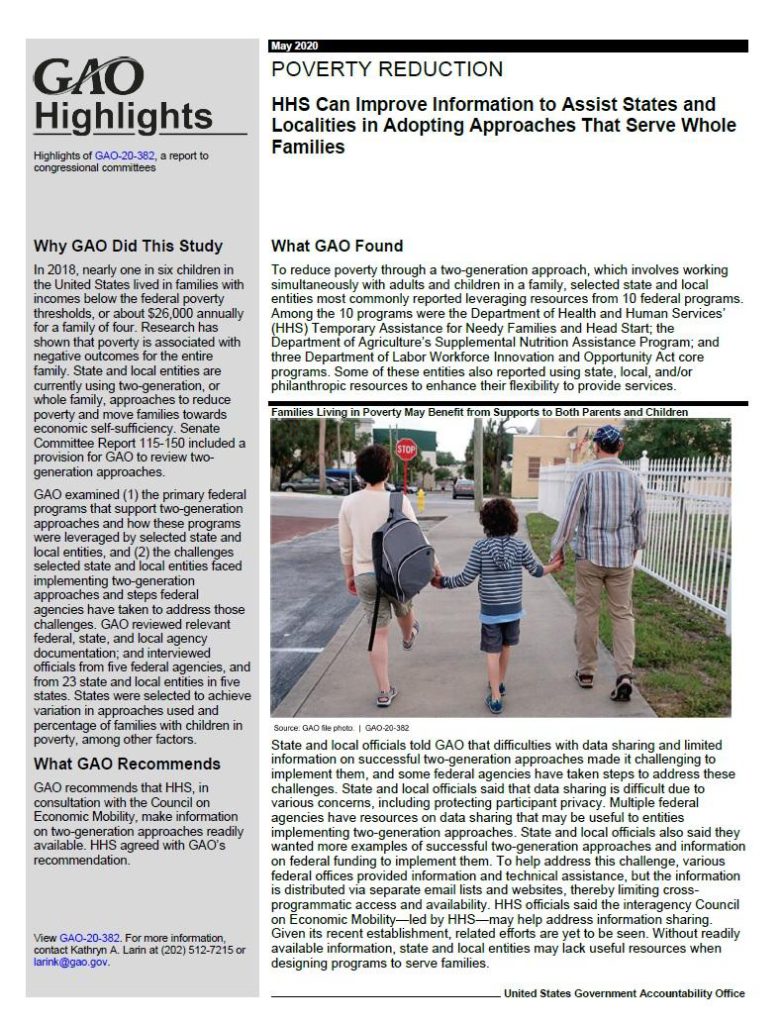As a life-long child advocate, I’ve come across great ideas that are difficult to pursue because of the siloed way that federal funding is too frequently made available – a specific purpose, specific targeting and eligibility rules and siloed administration. For me, who sees the connection between a family’s need for affordable housing and a parent’s need for child care to obtain and retain employment (which pays the rent), it’s a challenge to integrate the two concepts.
Children live in families. When a family has stable housing, the child benefits. When a parent has access to high-quality child care, the parent(s) can work and the child is in an environment that promotes their healthy development (and school readiness). Often, people refer to this as a two-generation strategy.
However, straddling the housing and child care assistance world is tough. For families earning low-incomes, the U.S. Department of Housing and Urban Development (HUD) provides funding for housing assistance. The U.S. Department of Health and Human Services (HHS) provides funding for child care assistance. Neither form of assistance is an entitlement, but together both better-position families (and their children) for success.
To me, our country needs a “Housing and Children First” plan, an integrated strategy to support families and their children. Nearly a decade ago, the Aspen Institute released Top Ten for 2Gen: Policy Ideas and Principles to Advance Two-Generation Efforts, which mentioned housing (among other programs) and listed principles for two-generation support. Those principles included:1
- Measure and account for outcomes for both children and their parents
- Engage and listen to the voices of families
- Foster innovation and evidence together
- Align and link systems and funding streams
- Prioritize intentional Implementation
- Ensure equity

We have made progress over the past decade, but more progress is needed! One example is HUD’s Family Self-Sufficiency program. The program currently serves around 65,000 participants at more than 700 Public Housing Authorities (PHAs) throughout the country.2 FSS is a voluntary program that uses a combination of coordinated services and supports from community partners and an escrow savings account to help participants grow their earned income and savings and increase their financial well-being overall. Federal housing funds are awarded to hire a Family Self-Sufficiency Coordinator or Case Manager who can help link families to community services such as child care. This needs to be a major focus of the family coordinator or case manager! The family coordinator/case manager needs to have training in the importance of quality child care in the early years. They need to think about families and children.
In North Carolina, Family Self-Sufficiency programs that link to child care services are operating in Asheville, Charlotte, Durham, and Greensboro.
For FY2022, Congress appropriated $113 million for the Family Self-Sufficiency program.3 Funds are awarded competitively. On May 17, 2022, HUD published a new FSS rule, which, among other updates, broadens the types of organizations that can apply for funding. Beyond Public Housing Authorities, for the first time, owners of private multifamily properties participating in the Section 8 assisted housing program are eligible to apply.
The FY2022 FSS Notice of Funding Opportunity (NOFO) competition was posted to Grants.gov and HUD.gov on August 4, 2022, with an application deadline of October 3, 2022. For more information about the grant opportunity, see HUD’s Family Self-Sufficiency web page. While direct services are not funded under the grant, coordination and case management can be helpful to link families to services they need within the community, including child care. Can this be a step toward Housing and Children First?
HUD’s Family Self-Sufficiency program is about integration of services. This is one necessary step, yet it is insufficient to meet family needs. More needs to be done across the country to better support low-income families with children, to meet both their housing and child care needs. In May 2020, the Government Accountability Office (GAO) released Poverty Reduction, HHS Can Improve Information to Assist States and Localities in Adopting Approaches that Serve Whole Families. After an extensive review of state and local two generational initiatives, the agency found that 11 of 23 state and local entities reported a lack of information on two-generation approaches. They also wanted examples of successful two-generation strategies, opportunities to learn from peers and information on federal funding sources that can be used.4
GAO’s chief recommendation for executive action: “The Secretary of HHS, in consultation with the Council on Economic Mobility, should make information that would assist state and local entities in developing and implementing two-generation poverty reduction approaches readily available across federal programs and offices.”5
In mid-August, the United States Interagency Council on Homelessness (USICH) announced that the USICH will be led by two members of the White House Cabinet, Veterans Affairs (VA) Secretary Denis McDonough and Health and Human Services (HHS)Secretary Xavier Becerra. HUD Secretary Marcia Fudge, the outgoing USICH council chair, led the vote. During her tenure, USICH launched the first-ever Interagency Working Group on Homelessness Prevention and helped implement the American Rescue Plan Act with a large single-year federal investment in homelessness. It is my hope that with Secretary Becerra in a leadership position with the USICH, there is yet another opportunity to have a Housing and Children First plan.
We can envision bold goals for two-generation support. We can develop a “Housing and Children First” plan. However, such efforts rely on states and localities understanding the federal funds available to offer integrated opportunities to better address the needs of families with children. While there are a number federal funding sources cited in the GAO report, review HUD’s Self-Sufficiency web page and see if the most recent grant opportunity is one for your community.
In addition, if your community is using ARPA funds for affordable housing, are you building spaces for families instead of only one-bedroom units? Is there a priority for spaces for families with young children? Have you considered setting aside spaces for pregnant women? Is your community also working with early childhood leadership to ensure there is quality child care? Families with young children need both housing and child care.
Let’s take the principles from the Aspen Institute report and the information from the GAO report and translate report recommendations to practice. We can do this. It’s time. Families with children depend on it.
Footnotes
1 Aspen Institute, Top Ten for 2Gen, Policy Ideas & Principles to Advance Two-Generation Efforts, October 2014. https://ascend-resources.aspeninstitute.org/resources/top-ten-for-2gen-policy-ideas-and-principles-to-advance-two-generation-efforts/ 2 U.S. Department of Health and Human Services, HUD Releases Economic Justice Agenda to Help Low-Income Renters Build Assets, August 4, 2022. https://www.hud.gov/press/press_releases_media_advisories/HUD_No_22_142 3 FY2022 Consolidated Appropriations Act, March 15, 2022, P.L. 117–103. https://www.congress.gov/117/plaws/publ103/PLAW-117publ103.pdf 4 Government Accountability Office (GAO), Poverty Reduction, HHS Can Improve Information to Assist States and Localities in Adopting Approaches that Serve Whole Families, GAO-20-382, May 2020. https://www.gao.gov/assets/gao-20-382.pdf 5 Ibid.





